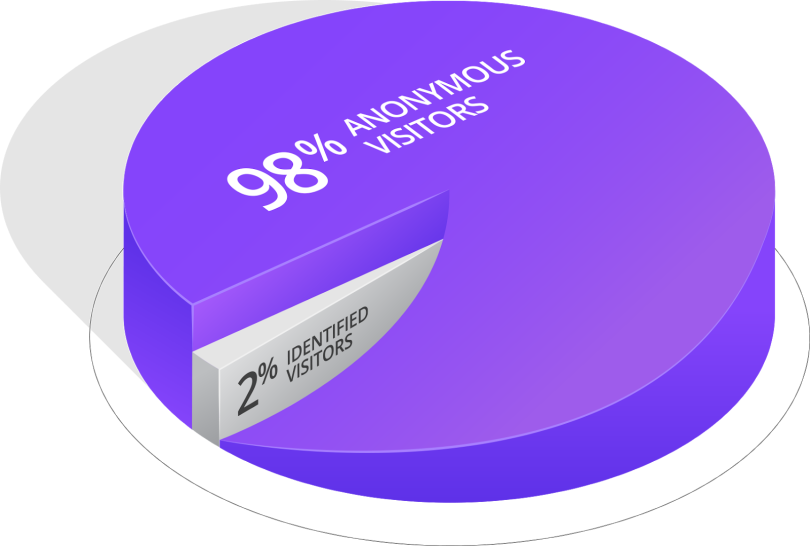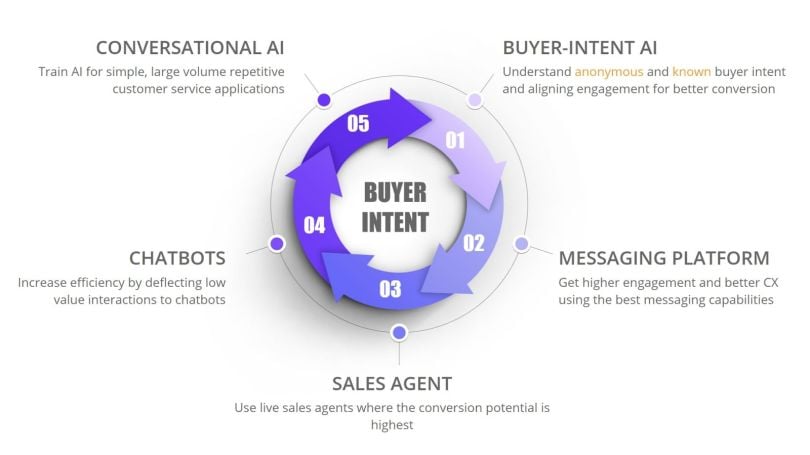If you follow the latest developments in the sales industry, you’ve probably noticed that the phrase “buyer intent” has been gaining significant traction over the past few years. Unlike other popular buzzwords that seem to come and go, buyer intent digs deep into the foundation of any sales process — and thus should gain your full attention.
G2, the largest tech marketplace, defines buyer intent as “the probability that a customer will purchase a product.” And it similarly defines buyer-intent tools as those that “capture research around actual buyer journeys and signs of their purchase intent.” In other words, buyer intent can be interpreted as a spectrum that measures how likely someone is to purchase a given product or service.
Think of a typical buyer journey today: Hardly anyone just visits a website (or walks into a retail store) without already doing some preliminary research. Since nearly all that research happens online (ideally on your website), you have to be able to discover and capture the buying intent of all website visitors.
The problem, however, is that most of your website visitors are anonymous. Marketo estimates that up to 98 percent of those who visit your website don’t have any apparent characteristics that could identify them in real time.
So how do you decipher the buyer intent of someone who is completely anonymous to you? Let’s start by taking a step back and reviewing the different types of visitor intelligence available today.

The Different Types of Visitor Intelligence Data
There’s a big difference between identifying a visitor and identifying their intent. In digital marketing, we typically work with three different types of intelligence in this arena:
- Identity: The attributes by which we can identify who a visitor actually is. This information may be in the form of an IP address that can be related to a corporate domain, a device ID that can be cross-referenced to prior identifiable behavior, a first- or third-party cookie that can identify the visitor by their prior website activity or an email address that can uniquely associate the visitor with online and offline information, often in a CRM system.
- Fit: The ability to profile the identified visitor against demographic attributes. (age, sex, income, etc.) In the case of an individual consumer, that might look like age, sex, income, etc. For a known business, this would include firmographic attributes such as company size, industry, annual revenue and more. In each case, marketers can segment and qualify their visitors in terms of their hypothetical fit for their product or service based on the data.
- Buyer Intent: The set of behavioral signals that show the intention of your prospects to purchase a product or service. Your prospects are actively seeking solutions and looking for vendors that might offer products or services to address the problems they have. They search online, consume content, conduct extensive reviews and ultimately leave a “digital exhaust” trail that shows what they’re possibly seeking.
Each data type serves a different purpose in advancing our understanding of website visitors, including which of those represent the best prospects to acquire our products and services — and thereby how we should invest resources to convert that interest.
The Problem With Identity-First Marketing
Conventional wisdom has been to first establish the identity of a visitor (e.g. find out who they are, what company they work for, their email address) and then see if their profile is a fit against your ideal customer profile and only then try to understand what their intent is for being on your website.
To summarize, the traditional approach is to decipher a visitor’s identity, then fit, then intent in that order. It's logical, but it's not the most effective way to capture the full potential of your website.
Why? Because this approach forces your visitors through a limiting filter of identity. Only those visitors who can be identified are profiled and ultimately engaged. In a world of ever-increasing privacy through the denial of cookies, the elimination of cross-website tracking and the increased use of VPNs, it is getting harder and harder to identify your website visitors. Considering the high barrier to obtaining identity information, that means only a fraction of your website traffic will be identified and engaged.
As mentioned above, Marketo famously declared that 98 percent of website visitors are anonymous with no identifying attributes. A whole industry has grown up around the desire to identify website visitors — or at least what company they may belong to. It's a challenge.
At the best of times, most data enhancement tools struggle to identify the individual visitors with more than a 20- to 30-percent success rate. Some tools may infer what company the visitor belongs to 50 to 60 percent of the time, but that's not the individual, just the organization. From there, marketers and sales teams will figure out if that identified individual has the right fit against their ideal customer profile, and only then go through the motions (via chat or other means) to determine if they’re even likely to buy or become a lead.
Run the math: If you can only identify 30 percent of your visitors (at best), what about the other 70 percent that makes up the vast majority of your traffic? If your marketing strategy is predicated on finding the identity of a visitor before you can qualify and engage them, you're not only missing out on the majority of the opportunity hitting your website, you're fighting the momentum toward ever greater privacy. This is the problem with identity-first marketing.
Intent: The Key to Unlock Your Full Potential
So how do you avoid the identity-first limitation? What if you could turn the conventional wisdom (and order of things) on its head? What if you could know the intent of every visitor on your website and then optimize your engagement tactics to convert the highest potential visitors with your best resources, maximizing your ROI on digital marketing?
Imagine if instead of the Identity → Fit → Intent sequence, it was Intent → Fit → Identity? First, you determine the intent of every visitor, then you determine if they're a good fit for your offering, and finally, you seek their identity once you have engaged them.
If you could do this, you'd no longer have to harass every visitor, asking for their email on the slightest pretext. More than 50 percent of visitors will abandon your web experience when you ask for an email address too early. So just like the best Nordstrom salesperson, you could let shoppers ask questions without asking them first for their personal information. Instead, you could determine their intent by observing their behavior and then engage those with the highest buying potential when the moment is just right.
What Is ‘Intent’ Exactly?
There are generally three types of intent that we encounter in digital marketing:
- In-Market Intent: This is the implied intent attributed to an individual visitor if that visitor can be successfully associated with the domain of a known corporation. Based on the recorded behavior of other individuals in the company on other web assets (or their engagement with published digital materials), you can form an in-market intent hypothesis that the company may be interested in or actively acquiring assets similar to your offering. This intelligence is primarily formed offline and requires the visitor's identification plus the relevant intelligence on that company's interest in your offering. It tends to be more generally used in account-based marketing strategies where marketers want to know if companies in their target segment are actively looking for their product or services so they can intensify their pursuit of those accounts.
- Conversational Intent: This is the ability through natural-language understanding to infer the intent being expressed in a chat dialog, otherwise known as conversational AI. It is extremely helpful in the increasing role that chatbot technology can play in the interaction between visitors and a brand. However, an actual chat dialog generally occurs in only a small number of visitor journeys — less than 2 percent. It cannot be applied in most customer journeys without forcing the visitor into an unwelcome chat dialog.
- Buyer Intent: This is the ability to assess the real-time intent of a website visitor based on their digital signature: How did they arrive on the site? What did they engage with and for how long? It's about their intent in the moment, and it is a very accurate predictor of their likelihood to convert. In digital marketing, buyer intent is also known as “purchase intent” and often as “behavioral intent”.
From the above descriptions, you can probably recognize that buyer intent has the potential to be the most effective type of intent as it doesn’t require any knowledge of the individual or their company, nor does it rely on trying to understand the nuances of a chat conversation — which only a few website visitors will have with you. Buyer intent gives you the ability to understand the intent of every single visitor on your website.
How to Determine Buyer Intent
When it comes to your website visitors, you want to categorize and focus on those who have high buyer intent. If connected to your sales team, those high-buyer-intent visitors are most likely to turn into customers and revenue.
Determining buyer intent isn’t simple. For it to be effective, it needs to be determined instantly while the visitors are on your site. According to Nielsen, the average page visit lasts less than a minute before the visitor leaves for another website. This means that you need to determine the visitor’s buyer intent and engage those with the highest buyer intent within seconds, when their interest is at its peak, through a real-time engagement tool such as chat.
That’s a tall order, and it’s not something that can be done by any human.
Buyer Intent and AI
AI today has a wide range of applications, but it’s especially valuable in identifying buyer intent and triggering an appropriate response (e.g. connecting high-quality leads to live sales chat). AI tools can quickly assess many thousands of website pathways and hundreds of other digital fingerprints, such as referral URLs, page views, time on page, page sequencing and more. These findings can then be tracked against millions of previous customer profiles and interactions. In the end, your success rate could rise from a meager 5 percent to over 90 percent. And it’s only possible thanks to AI and machine learning.

Buyer-Intent AI vs. Predictive Analytics
Monitoring a visitor's behavior and then applying rules in order to personalize their journey sounds a lot like predictive analytics. So what's new here?
Predictive analytics is an algorithmic technology that uses hypothetical projections and rules engines based on a limited number of data points. The hypothesis is human, typically a marketer's theory of what journey or pathway a high potential visitor will take. The human brain and rules engine technology we use to enforce the hypothesis is limited in terms of the number of permutations we can envision and the number of data points we can assess and apply through those algorithms. Simply put, it's limited by our human brain’s capacity to compute all the variants and our bias to optimistically express outcomes. Sounds fancy, right?
So what's different about buyer intent AI? Machine learning. ML (and the computing power available to execute it) allows you to examine thousands of data points when you don't even know if they will be informative or causal to each individual's behavior. Only ML can assess such a vast array of data points and then compare every permutation against billions of known outcomes to train the models to predict an individual's buying intent and do it in real time.
Just as ML opened the door to self-driving cars, so it has radically changed how we can predict the buying intent of every visitor — known or anonymous.
How to Use Buyer-Intent AI Today
The difference between traditional predictive analytics and buyer-intent AI tools is similar to the difference between recreational and commercial fishing. You could be casting off the pier with the best rod, bait and tackle available and still not catch anything significant. At the same time, commercial fishermen are using radar and sonar to locate the fish and deploy the right nets to maximize their catch.
When it comes to sales, buyer-intent AI is your radar and sonar. It helps you identify every visitor with high buyer-intent and then use the right tool (e.g. a messaging platform) to engage them. Buyer-intent AI tools can even serve lower-scoring visitors with options appropriate for them, such as chatbots that are proactive (for medium scores) or reactive (for low scores).

The buyer-intent approach means that instead of the industry-average conversion rates of 1 to 2 percent via newsletters and contact forms, you can widen your engagement and revenue potential to all visitors, whether they are known or completely anonymous.
Additionally, AI never stops improving or adapting, and it feeds off data like seasonal variations, competitors’ pricing models, product feature sets and so on. No team of salespeople is able to analyze data this quickly.
The bottom line is this: Your sales team has an unprecedented opportunity to leverage the power of buyer-intent AI tools to dramatically increase website engagement. First, they can choose to only communicate live with visitors who show the highest buyer intent. Second, they can produce custom playbooks and questions that will be shown to further qualify low-scoring visitors through a chatbot, without taking up any time from your team. By implementing this strategy, a cloud-based healthcare provider PointClickCare has recently increased its conversions and revenue per visitor by 400 percent. Follow the game plan laid out above, and those results could be within reach for your company too.





